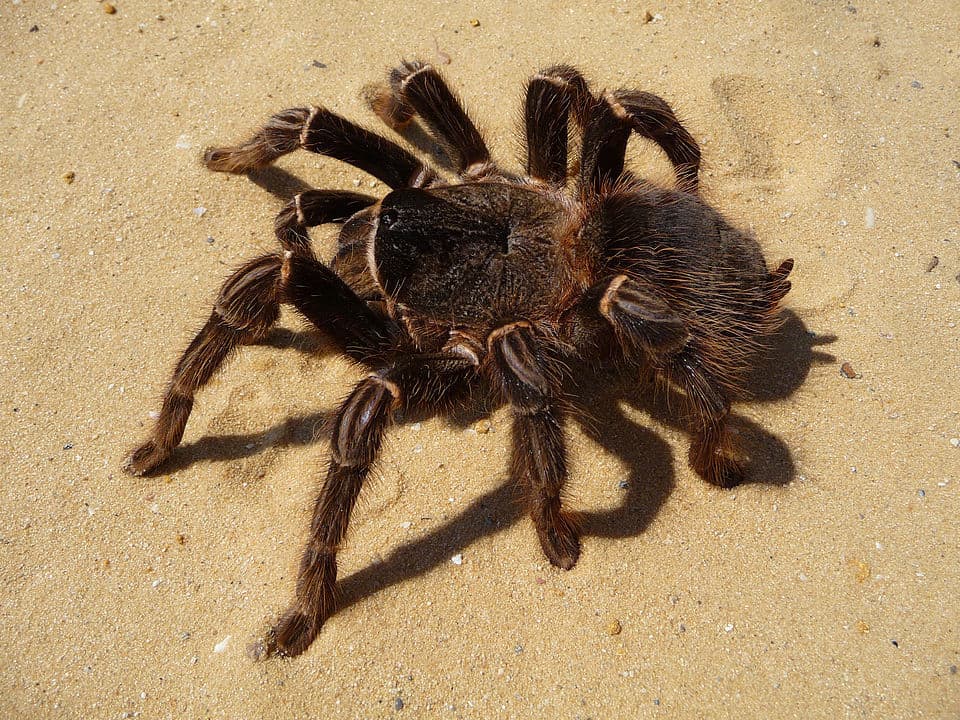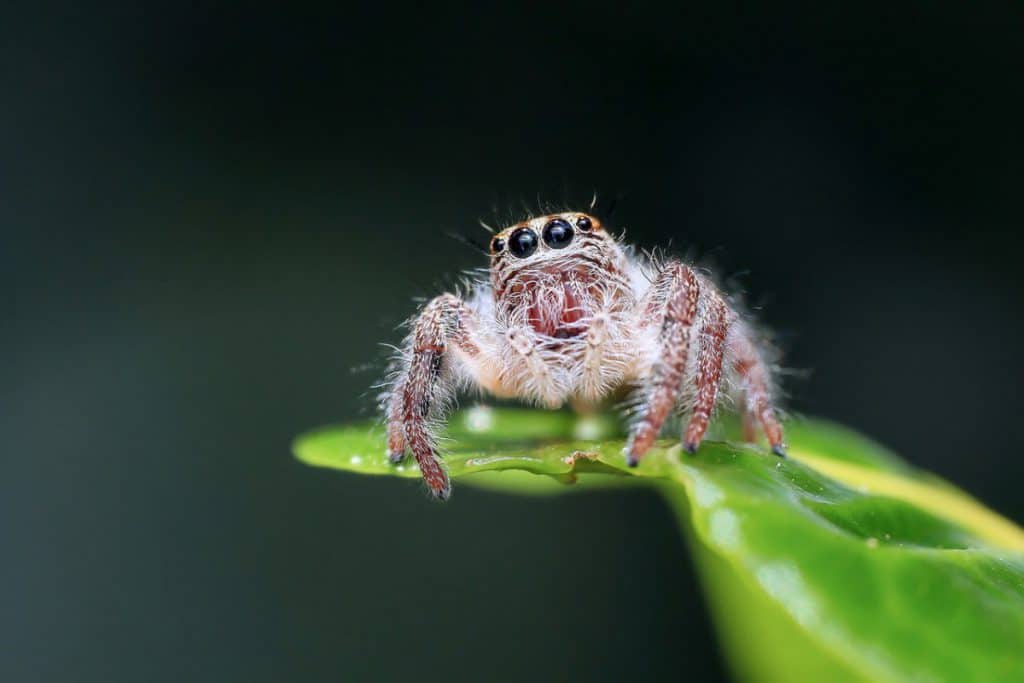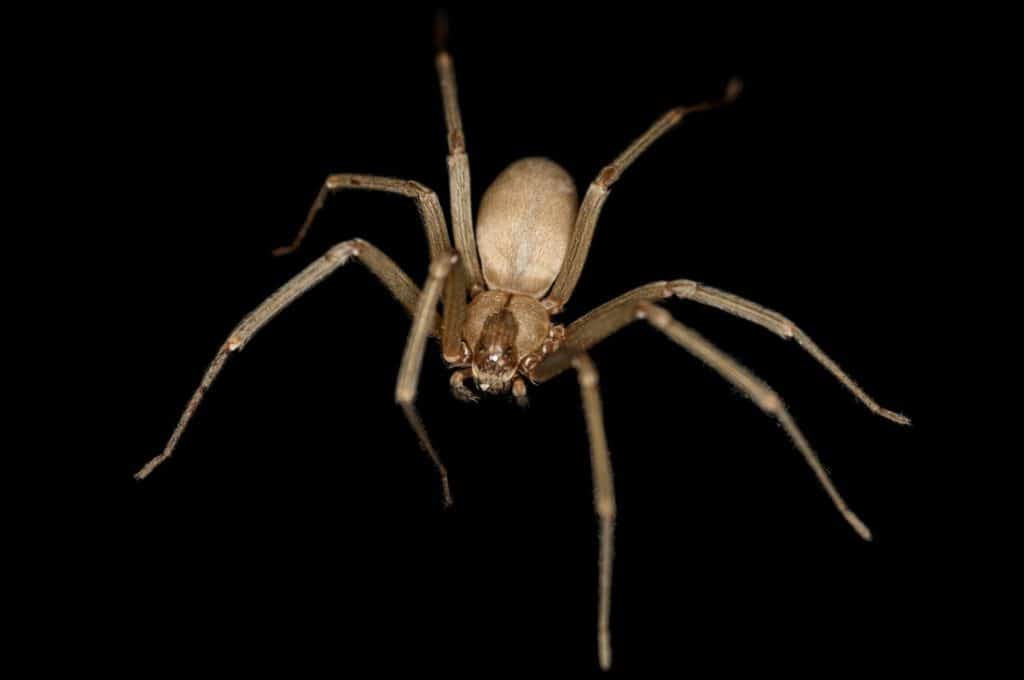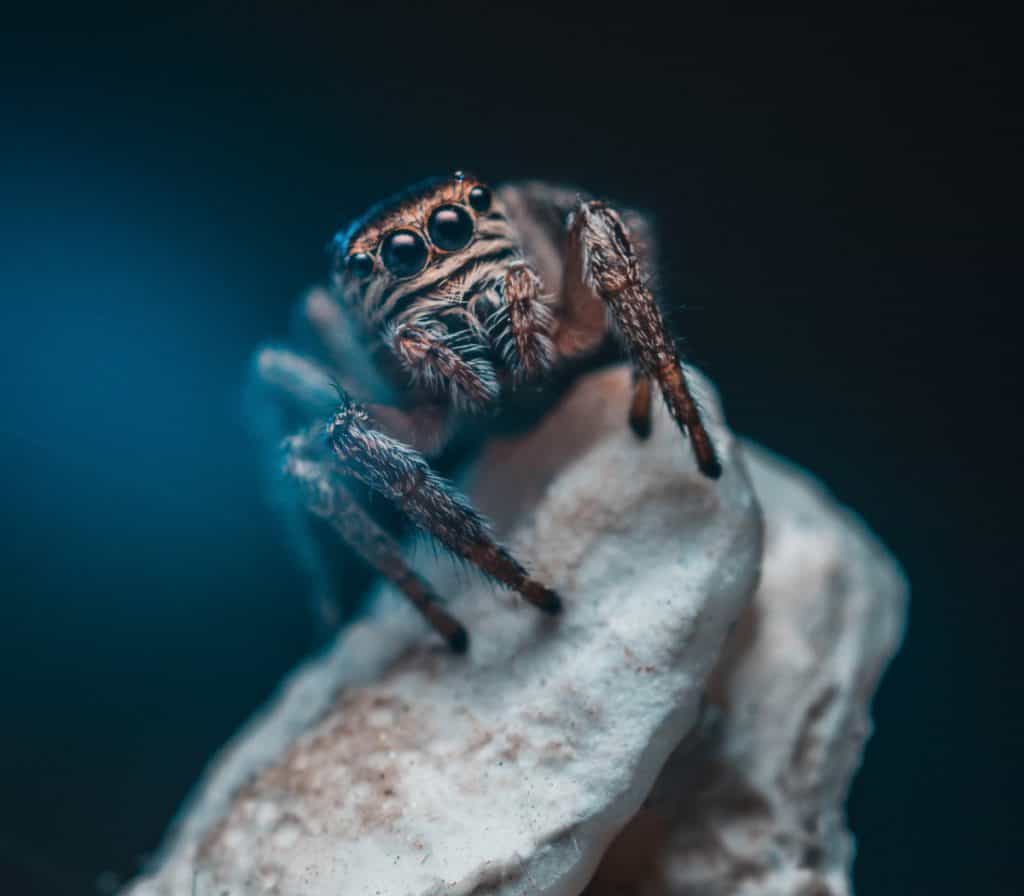If you enjoy reading this article, why not check out our articles on Where Do Wolf Spiders Go in the Winter? and How Small Can Spiders Get? Real Small!
Picking the Right Spider For You
Should you have come to the point where you are ready to purchase/adopt a spider as your pet, you may already have some preconceived notions about which kind of spider is, “The coolest,” or you think sounds the most fun. Well, as with any other pet like dogs or cats (which have certain breeds that are better suited for some owners than others) you might think one type of spider is the best selection for you, but in actuality, there are a number of factors to consider.
What is the best spider to keep as a pet?
With that said, generally, the best spiders to have as pets are Tarantulas, which have a number of sub-species that all have assorted reasons they are great to keep as a pet. When it comes to why Tarantulas are usually the best kind of spider to have as pets that will be explored shortly below in a listing that will break-down the kinds of spiders sometimes kept as pets along with various factors that make them better-suited to being pets (a good temperament) or less-than-optimal for certain households (like how highly poisonous spiders should not be kept in a house with children).
If you’re going to get a pet tarantula, though, you definitely have to learn a lot about them. Do Pet Tarantulas Bite? Yes and No would be a good place to start!
Guidelines for Choosing A Pet Spider
At the end of the day YOU are of course the person making the decision about which spider you want to take home, but by reading this article you’ll hopefully also have a clearer idea of which kind of spider will be the best for you in the long run so that you have a content spider that lives a long life! Before we further break-down which kinds of spiders make the best pets however, it is worth examining why spiders make good pets in the first place.
Benefits of Having a Spider as a Pet
What is the friendliest spider?
When you have a spider as a pet–the recommended kind of Tarantula or any other kind–it brings with it a lot of advantage compared to other pets. Whereas some pets may bark, meow, or otherwise howl loudly, spiders are quiet–you’ll never hear them making a fuss! Also, compared to pets that roam around your house knocking into furniture and getting-into garbage, spiders are neat and just need a relatively small amount of space in a terrarium where they will happily make such a spot their cozy home.
What do pet spiders eat?
If you’re considering a spider as a pet you already probably know how fascinating they are to watch, and they cost a lot less than most pets–even other kinds often kept in a smaller enclosure such as Guinea Pigs can often end up costing more than a spider. Spiders also generally are pretty inexpensive to feed, with only the largest ones requiring anything beyond crickets or mealworms.
For more information on a spider’s diet, read our article What Do Spiders Eat? The Complete Guide.
Is a spider a good pet?
Plus, while you may want to own more than one spider should you find it enjoyable, you don’t have to own multiple spiders as they are quite often solitary creatures who do not get lonely without another one around–in fact, two spiders stuck in close proximity are quite likely to fight as opposed to being pleased (unless it is a male and female who mate, but that is something only experts at keeping spiders as pets need to concern themselves with). While many pets need another animal around to keep them company, a single spider is quite satisfied in its little comfy terrarium all by itself where it can enjoy the days.
Is a tarantula a good pet?

Now, as was mentioned, Tarantulas are the best kind of spider to keep as a pet, but there are multiple kinds of Tarantulas, with the three that arguably make the best pets all deserving of discussion of various factors about them.
Rose Hair Tarantula
Cost of Purchase: Usually $20-$60 depending on the store, region, and Tarantula’s size
Cost of Feeding: Low
Ease of Handling: Docile and Tolerant
Suitability for Children: Relatively Safe
Poisonous to Humans or Not: Minor Concerns
General Information: Also at times referred to as a “Chile Rose Tarantula,” or, “Pink Rose Tarantula,” the name is due to a lighter and almost pinkish-hue often observed on their fur. Arguably the best option of all the Tarantulas listed, it is therefore worth discussing the Rose Hair Tarantula first. Relatively inexpensive to purchase and easy to feed with crickets and/or mealworms, the Rose Hair Tarantula is also one of the most mellow and relaxed spiders you’ll ever meet.
Are rose hair tarantulas friendly?
They are generally very docile and tolerant of being handled, especially if it happens on occasion so that they can grow used to it–although excessive handling can lead to stress for the spider and the possibility of getting bitten by the Rose Hair Tarantula. Speaking of being bitten, it is only a minor concern. All spiders are of course venomous, but only some are especially poisonous to humans, with a Rose Hair Tarantula bite most likely causing some minor pain via itching and burning in the area it chomped-down on should one choose to bite you.
How do you deal with a rose hair tarantula?
The fact that they are generally quite mellow and relaxed makes their tolerant selves a relatively safe choice for children to have as pets as long as anytime the children are interacting with them the proper steps are of course taken to ensure everyone stays safe–e.g. the kid most likely won’t get bitten or the Rose Hair Tarantula will not accidentally be dropped which could lead to its injury or death. The other Tarantulas about to be discussed make quality pets as well, but the Rose Hair Tarantula is right-off-the-bat generally the preferred choice for owners of spiders, especially those who may be owning their first one!
If you’re seriously considering getting a Rose Hair Tarantula as a pet, read Everything You Need to Know About Rose Hair Tarantulas to help you make a final decision!
Pink-Toed Tarantula

Cost of Purchase: Usually $25-$80 depending on the store, region, and Tarantula’s size
Cost of Feeding: Low
Ease of Handling: Likely to Jump Away
Suitability for Children: Challenging
Poisonous to Humans or Not: Minor Concerns
General Information: True to its name, the Pink-Toed Tarantula can have feet which at their end look quite a bit like small, pink-ish toes. Not overly expensive, they can run a bit higher if you are seeking one out which was especially notable, “Toes,” as some owners will pay extra for such a so-called feature. Easy to feed, the Pink-Toed Tarantula is often satisfied with a diet consisting of insects such as crickets or mealworms. When it comes to handling a Pink-Toed Tarantula it should be noted they are less tolerant of being handled compared to some types of Tarantula (such as the Rose Hair Tarantula) and may exercise their impressive jumping-ability should they tire of being held and want to bound-away from a (sure-to-be-surprised) owner.
Are pink toed tarantulas aggressive?
The Pink-Toed Tarantula is not overly aggressive by any means, more likely to try and exercise their aforementioned impressive jumping to escape what they perceive as danger or discomfort than they are to try and bite an owner. With that said, should they bite it will just result in some minor pain in the form of itching, burning, and slight discomfort as opposed to any kind of extensive yelling of, “OUCH!”
Can you hold a pink toe tarantula?
Due to how the Pink-Toed Tarantula is not especially fond of handling and if they are not carefully watched can jump-out of your hands or even possibly an enclosure with the lid not connected, this makes them more challenging for children and not necessarily the best choice for young ones to keep as pets. Also, those who desire to be able to handle their Tarantulas somewhat often will probably want to pass on owning a Pink-Toed Tarantula. With that said, someone who is a bit more familiar with having Tarantulas as pets may find a Pink-Toed Tarantula is right up their alley!
Curly-Haired Tarantula
Cost of Purchase: Usually $25-$65 depending on the store, region, and Tarantula’s size
Cost of Feeding: Low-to-Moderate
Ease of Handling: Calm and Docile
Suitability for Children: Relatively Safe
Poisonous to Humans or Not: Minor Concerns
General Information: The Curly-Haired Tarantula lives-up to its name via just how busy it can look! It also can grow to quite a large size. It is generally not very expensive to buy one that is not yet too big and when it comes to feeding a Curly-Haired Tarantula younger/smaller ones are pleased with crickets as well as mealworms. However, larger Curly-Haired Tarantulas may desire bigger-fare, enjoying snacking on small lizards and even mice! This can result in feeding Curly Haired-Tarantulas being a bit more expensive than some of the other Tarantulas discussed which do not require nearly as much spent on feeding them (the Rose Hair Tarantula and Pink-Toed Tarantula, for example, subsist fine their entire lives on crickets and mealworms).
Are curly hair tarantulas aggressive?
The Curly-Haired Tarantula is relatively calm and docile, making it not too difficult to handle as long as one practice common-sense of getting it slowly acclimated to the process and not handling it to an excessive degree–this, of course, can cause a good deal of stress for the Curly-Haired Tarantula and result in it possibly biting. In regards to its bite, there is an only minor concern to be had. A bite from a Curly-Haired Tarantula will result in some localized (the spot where it bit) burning, itching, and stinging, but it is mild for most people, and as the Curly-Haired Tarantula tends to be quite mellow the odds of it biting if handled with reasonable care are minimal.
Do curly hair tarantulas need humidity?
Due to their calm and relaxed nature, Curly-Haired Tarantulas are a relatively safe pet to have in proximity to children. Any young ones handling a Curly-Haired Tarantula, of course, need to have an adult supervising them so as to make sure both the child and Tarantula are safe (nobody wants to get bitten or dropped), and as they can grow quite large a child may need to hold Curly-Haired Tarantula with both hands, especially if it is relaxing and stretching-out. While the Rose Hair Tarantula may most often be found for sale in stores and is highly recommended, the Curly-Haired Tarantula is also a fantastic spider to have as a pet.
Other Spiders of Note
It is not unheard of for people to go out and try and catch spiders they then keep as pets. This can include any kind of spider from Wolf spiders to the more aquatic fishing spiders. While it is completely possible to keep these spiders in captivity it can be harder as pet stores may not sell food specifically for them.
Also, while some spider-aficionados will actually keep spiders known to be highly poisonous to humans as pets (such as the Black Widow) this is again not recommended for anyone but the most experienced of owners (and those without curious small children) as should this type of spider escape its enclosure it can be quite a cause for alarm! Hence, while it is possible to keep a wide-range of spiders as pets, should you be someone relatively new to starting-out with being a spider owner having one of the above-listed species of Tarantula is 100% recommended over trying to catch a Brown Recluse or Hobo Spider to keep and possibly suffering a nasty and poisonous bite as a result.
Final Thoughts
Spiders–and Tarantulas in particular–can make wonderful pets for a number of reasons, and when it comes to deciding which one is best for you this article has hopefully been quite helpful with the decision-making process. At the end of the day when you have the spider that you know is right for you, it will be a rewarding experience keeping it fed, comfy, and content.
Also, without a doubt it is a great way to teach a child responds with a pet that (as mentioned) takes up a lot less space than other ones and is less demanding of attention than a cat or dog. While smaller children should not be alone when caring for or handling a spider, they can still have a wonderful time watching it in its terrarium as it goes about its fascinating business and will be proud as it grows and thrives. Having a spider as a pet is not for everyone, but almost everyone who does have a spider as a pet loves it, and that right there sums everything up pretty nicely!
If you enjoyed reading this article, why not check out our articles on How To Get Rid of Spiders Naturally and Should You Kill Spiders? Short Answer No.
Recent Posts
Tiny Black Bugs in Bathroom NO WINGS: What They Are and What to Do!
Finding tiny black bugs in your bathroom can be uncomfortable, to say the least. Especially if they are persistent, or they appear in very large numbers, which they often like to do. When it...
Tiny Black Bugs in Plant Soil - What Are They & What To Do About It
A short horror story: You get a new houseplant. You do your best to take care of it. You’ve ensured that it has the right soil, the right amount of sun, it gets enough water. And then one day, you...




